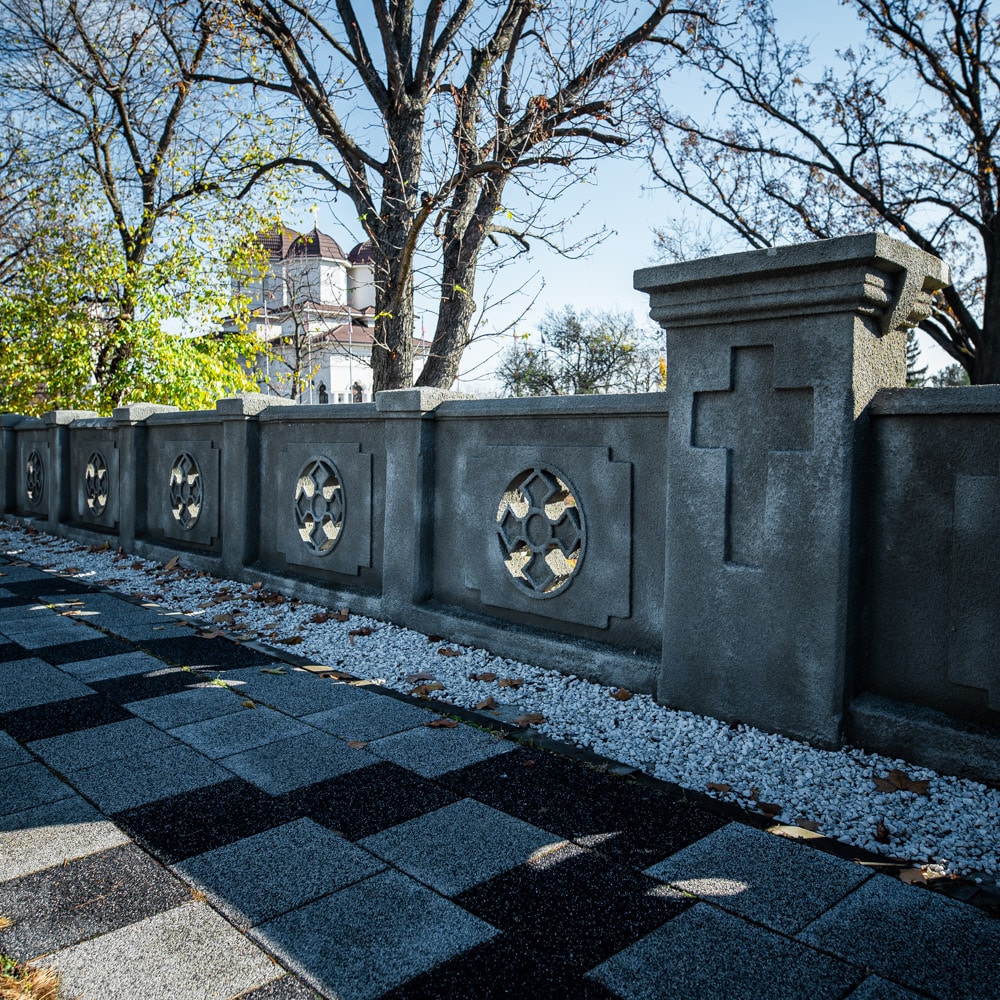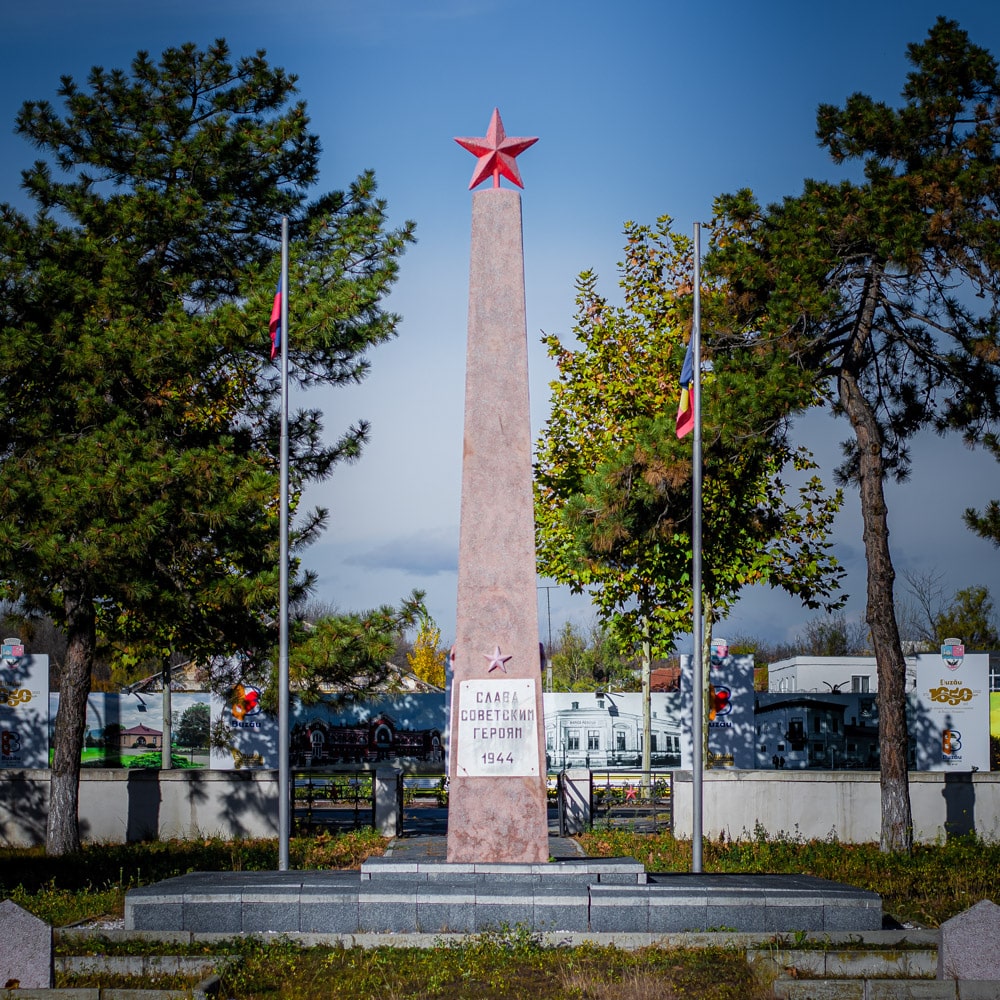
Zidul perimetral al Bisericii și Cimitirului Eroilor
noiembrie 10, 2022
Cimitirul Dumbrava
noiembrie 10, 2022Română
CIMITIRUL SOVIETIC
Armata sovietică a ocupat Buzăul în data de 28 august 1944 şi, deoarece soldaţii germani erau baricadaţi în Palatul Comunal, s-a tras cu tunul, o parte din clădire arzând împreună cu arhiva. Tot atunci a ars şi importanta colecţie de carte donată bibliotecii oraşului de marele om politic buzoian Alexandru Marghiloman. Constituirea, în prelungirea Cimitirului Eroilor din Buzău, în partea de vest a acestuia, a unui cimitir al ostaşilor sovietici căzuţi în timpul celui de-Al Doilea Război Mondial, nu a făcut decât să întărească o stare de spirit creştin, îngăduitor, al cetăţenilor oraşului Buzău. Aici sunt înhumaţi în gropi individuale sau comune, 392 de miliari sovietici, căzuţi în luptele cu militarii germani ce se retrăgeau spre Transilvania, după 23 august 1944, pe raza judeţului Buzău. În cimitir regăsim 10 semne funerare mari pentru mormintele comune şi 16 semne funerare mici pentru mormintele individuale. Monumentul funerar, un obelisc din beton mozaicat, sub forma unui trunchi de piramidă, înalt de 6.2 m, are în vârf o stea roşie în cinci colţuri din metal, iar pe fiecare latură se găseşte câte o stea roşie. Pe obelisc este o inscripţie în limba rusă şi în limba română, înscrisă pe trei laturi: „Glorie eternă ostaşilor armatei sovietice care şi-au dat viaţa în lupta pentru eliberarea omenirii de robia fascistă”.
English
THE SOVIET CEMETERY
The Soviet army occupied Buzău on 28th August 1944 and, since the German soldiers were barricaded in the Communal Palace, a cannon was fired, part of the building burning together with the archive. This was also the moment when the important book collection donated to the city library by the great politician from Buzău, Alexandru Marghiloman burned. The establishment, in the extension of the Heroes' Cemetery of Buzău, in its western part, of a cemetery for Soviet soldiers who fell during the Second World War, only strengthened a Christian, forgiving state of mind of Buzău city's citizens. Here, 392 Soviet soldiers are buried in individual or common graves, fallen in the battles with the German soldiers who were retreating towards Transylvania, after 23rd August 1944, within the radius of Buzău county. In the cemetery we find 10 large grave markers for common graves and 16 small grave markers for individual graves. The funerary monument, a composite concrete obelisk, in the shape of a pyramid trunk, 6.20 m high, has a red metal five-pointed star at the top, and on each side, there is a red star. On the obelisk there is an inscription in Russian and Romanian, written on three sides: "Eternal glory to the soldiers of the Soviet army who gave their lives in the fight for the liberation of mankind from fascist slavery".
Français
CIMETIÈRE SOVIÉTIQUE
L'armée soviétique a occupé la ville de Buzău le 28 août 1944 et, alors que les soldats allemands étaient barricadés dans le Palais Communal, des coups de canon ont été tirés et une partie du bâtiment a brûlé ainsi que les archives. C'est également à ce moment-là que l'importante collection de livres donnée à la bibliothèque de la ville par le grand homme politique de Buzău, Alexandru Marghloman, a brûlé. La création d'un cimetière pour les soldats soviétiques morts pendant la Seconde Guerre Mondiale dans l'extension du Cimetière des Héros de Buzău, sur le côté ouest du cimetière, n'a fait que renforcer l'esprit chrétien et indulgent des citoyens de Buzău. Ici sont enterrés dans des tombes individuelles ou collectives 392 militaires soldats, tombés dans les combats avec les soldats allemands se retirant vers la Transylvanie après le 23 août 1944, dans la région du département de Buzău. Dans le cimetière, il y a 10 grandes signes tombales pour les tombes collectives et 16 petites signes tombales pour les tombes individuelles. Le monument funéraire, un obélisque en béton mosaïque en forme de tronc de pyramide de 6,20 m de haut, porte au sommet une étoile métallique rouge à cinq branches, et de chaque côté, une étoile rouge. Sur l'obélisque il y a une inscription en russe et en roumain, écrite sur trois côtés : «Gloire éternelle aux soldats de l'armée soviétique qui ont donné leur vie dans la lutte pour libérer l'humanité de l'esclavage fasciste».




